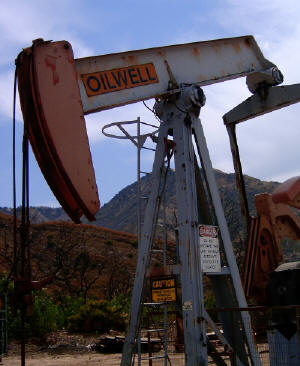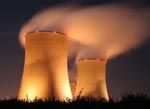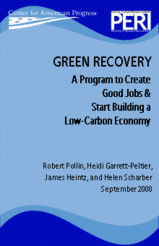News
400 ppm and Counting
May 26, 2013
 The only question now is whether the relentless rise in carbon can be matched by a relentless rise in the activism necessary to stop it. —Bill McKibben
The only question now is whether the relentless rise in carbon can be matched by a relentless rise in the activism necessary to stop it. —Bill McKibben
The CO2 level in our atmosphere has reached 400 parts per million (ppm), higher than at any time in the past 3 million years. The annual rate of increase has also accelerated over the past 55 years from about 1.55 ppm to more than 2.5 ppm.
NASA recently polled ten climate scientists on their reaction to this landmark number, and it is revealing how mild their reactions seem. No one is standing on a chair, screaming hysterically for change in our energy policies. This speaks to the success the radical right has had in pooh-poohing climate change. The scientists who know best the awful future we are facing are keenly sensitive to appearing to be alarmist, though we are now past the time when alarm bells should have reached deafening levels around the globe.
Obama will soon approve or disapprove the Keystone XL pipeline. The pipeline would bring tar sands oil from Alberta, Canada, to other pipelines already under construction in the U.S. that would deliver it to refineries in Texas. Though in and of itself the pipeline will not increase the CO2 levels spewing into the atmosphere—if this pipeline is not approved, Alberta will find a way to ship their product to the orient— it isn’t going to help, either.
We need an energy initiative at least as ambitious as our race to the moon in the 1960s, and much more vital to all our interests. Here is one idea: Let’s cut our use of fossil fuels by 4% every year for the next 25 years. Cut our imports and cut our domestic production and utilization. In a quarter of a century, we can get to the point where we contribute nothing to the growth of greenhouse gas emissions, at least insofar as they are caused by the burning of fossil fuels. Of course, along the way, we are going to have to maximize conservation, development of renewables, and research and development aimed at keeping the lights on and the traffic moving after 2038. Is there anyone, knowing of our wealth and our resources, who can seriously doubt we could succeed?
On the other hand, knowing what we know about the way the world runs in 2013, is there anyone who can seriously believe we will embark upon anything like this in the foreseeable future? More to be expected is that we will continue our inexorable march to the Land of No Return.
One for the Good Guys
Mar 04, 2010
 Update: March 3, 2010: Let the Rehabilitation Begin!
Update: March 3, 2010: Let the Rehabilitation Begin!
The first piece on saving Vermont Yankee to appear in the Times2 did so barely a week after the Vermont Senate vote to deny Entergy their bid for a 20-year extension to operate the plant. The focus this time: What will become of poor, doughty Vernon, VT, when the plant shuts down in 2012?
Originally published February 26, 2010
The corporatocracy which, today, controls the nation’s social, political, and economic life, for the apparent sole purpose of filling top management’s pockets (customers, stockholders, and workers be damned), took a small hit a couple of days ago when the Vermont Senate voted 26-4 to deny Entergy a 20-year extension to run the Vermont Yankee nuclear plant. It is the first time in 20 years that the public or its representatives has decided to close such a facility.1
By all accounts, including Entergy’s, Vermont Yankee (VY) is a mess. The 38-year-old plant is leaking radioactive tritium, one of its cooling towers collapsed in 2007, plant owners lied—excuse me, misspoke—in testimony before two state panels regarding the condition of the facility, and Entergy has been attempting to elude their decommissioning responsibilities by selling off VY and a few other aging facilities to a new corporate entity of their own devising.
One VT senator, otherwise relatively sympathetic to the nuclear industry, opined to the effect that Entergy could not have done a better job of shooting themselves in the foot had their upper management been infiltrated by anti-nuclear activists.
Entergy vows to fight on, and I am sure they will have powerful backers. Check with us in March 2012 to see if VY will really have to close its doors. Knowing the state of the nation, my heart is with the people of Vermont, but my money is on Entergy.
No one wants to see the lights go out, and nuclear energy is undeniably essential to avoiding that event today. However, it is a suicidal means of generating electricity, and our leaders must not only set a priority on promoting the necessary development of green technologies, but they must be seen to be doing so. In that context, Obama’s recent boosterizing of the nuclear industry was yet another disappointment to his quickly vanishing base.
________________________________
1 Vermont Senate Votes to Close Nuclear Plant, by Matthew L. Wald, from the New York Times, Feb 24, 2010, accessed Feb 25, 2010.
2 Town Finds Good Neighbor in Nuclear Plant, by Katie Zezima, from the New York Times, Mar 3, 2010, accessed Mar 4, 2010.
Taking the Sales Out of Your Wind
Feb 08, 2009
 In 2008, we blew away all previous records in new wind power infrastructure installation. Our national wind power generating capacity swelled by 50 percent, with 8,358 megawatts of new generating capacity installed. That is enough to power over 2 million homes and makes wind power one of the leading sources of new power generation in the country today. The new installations channeled $17 billion into the economy. Jobs in the wind industry are up by 70 percent in the last year, from 50,000 to 85,000, many in the wind turbine manufacturing industry, which we have been slow to get into, letting our European friends get an early jump on us. Our share of domestically manufactured wind turbine components finally reached 50 percent in 2008.
In 2008, we blew away all previous records in new wind power infrastructure installation. Our national wind power generating capacity swelled by 50 percent, with 8,358 megawatts of new generating capacity installed. That is enough to power over 2 million homes and makes wind power one of the leading sources of new power generation in the country today. The new installations channeled $17 billion into the economy. Jobs in the wind industry are up by 70 percent in the last year, from 50,000 to 85,000, many in the wind turbine manufacturing industry, which we have been slow to get into, letting our European friends get an early jump on us. Our share of domestically manufactured wind turbine components finally reached 50 percent in 2008.
This according to the American Wind Energy Association in their January 27, 2009, press release, Wind Energy Grows by Record 8,300 MW in 2008. But don’t break out the champagne yet.
Toward the end of last year, new turbine orders slowed to a trickle and if the Obama stimulus doesn’t happen soon, and bolster the tax credits and subsidies for this nascent industry, we could be in for some serious backsliding. Wind power is clean and renewable, and it has already provided a significant boost to our manufacturing and job creation capacities. It is an essential part of both our short-term and long-term recovery plans. Momentum such as it has enjoyed in the last year cannot be allowed to stall. Write your congressional delegation and tell them to make sure there is a high wind in the stimulus package.
Green Is Gold
Sep 26, 2008
 Remember that check you got from Uncle Sam last summer, the one that was going to jump-start the economy and get it back in shape? How’s that working out?
Remember that check you got from Uncle Sam last summer, the one that was going to jump-start the economy and get it back in shape? How’s that working out?
Okay, never mind. However, we could have taken that roughly $100 billion and put it into a plan devised by the Center for American Progress and the Political Economy Research Institute (PERI) at the University of Massachusetts/Amherst. For the same amount of money, raised through auctioning off carbon permits, we could invest in the following six energy strategies:
- Retrofitting buildings to improve energy efficiency
- Expanding mass transit and freight rail
- Constructing “smart” electrical grid transmission systems
- Wind power
- Solar power
- Next-generation biofuels
The road to recovery is paved with gold, if we can find ourselves a way around the dead end that is the fossil fuel-based economy.
Well, Blow Me Down!
Jun 06, 2008
 Here Comes Wind Power. In a report released by the Department of Energy and the Lawrence Berkeley National Laboratory, "wind projects accounted for 35 percent of all new electricity-generating capacity added in the U.S. in 2007, and more than 200 GW (gigawatts, or billion watts) of wind power are in various stages of development throughout the country."
Here Comes Wind Power. In a report released by the Department of Energy and the Lawrence Berkeley National Laboratory, "wind projects accounted for 35 percent of all new electricity-generating capacity added in the U.S. in 2007, and more than 200 GW (gigawatts, or billion watts) of wind power are in various stages of development throughout the country."
Fill ’Er Up!
May 26, 2008
The Consumer Federation of America, a consortium of over 300 nonprofit, pro-consumer organizations, released its first quarterly report on consumption, prices, and imports of oil: Ending America’s Oil Addiction (18 pp.). Among its more notable findings:
- Per capita gas consumption is down about 6% since 2004.
- Automobiles emit about 23.9 pounds of CO2 gas for every gallon of gas consumed.
- In the first quarter of 2007, that amounted to about 400 million tons of CO2 emitted into the atmosphere.
- The price of gas today is over 150% higher than in 2002, with an increase of almost $2.00 per gallon.
- Over the past three years, polls indicate that more of us are expressing “great concern” over oil prices (73% today versus 46% in 2004). We‘re also more concerned over the effect of increasing imports on national security (60% to 48%). However, the percent expressing “great concern” over global warming in that period has only inched up from 36 to 37%.
- Large increases in prices and expenditures are not being nearly matched by declines in consumption.
- Sales of more fuel-efficient vehicles are on the rise but, again, not in proportion to the increased costs of fuel.
- The CFA’s conclusions may be summarized thus: We care about the issues involved in our addiction to oil, but are unable to do much about them without congressional mandates for more fuel-efficient standards and through the implementation of other measures.
Copyright © 2008 All Together Now.